Introduction
Sudan, an African country with a remarkable history, culture, and significant recent changes, is a nation of contrast. From its ancient civilization to its modern conflicts, Sudan has a unique place in the world. This article will explore Sudan’s history, geography, people, economy, and current challenges.
Sudan is a country worth understanding due to its fascinating history, cultural diversity, and significant political and economic transformations. This easy-to-read article offers a comprehensive look at Sudan’s unique story and its impact on the global stage.
Table of Contents
- Overview of Sudan
- Geographical Significance of Sudan
- The Rich History of Sudan
- Cultural Diversity in Sudan
- Sudan’s Economic Landscape
- Political Landscape and Recent Changes
- Humanitarian Challenges in Sudan
- Sudan’s International Relations
- FAQs about Sudan
- Conclusion
Overview of Sudan
Sudan, located in northeastern Africa, is bordered by Egypt, Eritrea, Ethiopia, South Sudan, and other countries. It is the third-largest country in Africa. Sudan has faced many challenges, such as political instability, civil wars, and economic issues, yet remains an essential player in Africa and the Arab world. Sudan’s history, cultural diversity, and natural resources make it a crucial region in Africa.
Geographical Significance of Sudan
Sud an’s geography is significant due to its strategic location along the Nile River. The river is essential for agriculture, especially as Sud an is mostly desert with limited arable land. Sud an’s northern areas are dry, while the southern regions have more rain and vegetation. The Nile provides water for crops and communities, sustaining the livelihoods of many Sud anese people.
Sud an’s landscape includes deserts, savannas, and mountainous areas, creating diverse ecosystems. These geographical variations contribute to the country’s rich biodiversity. Sud an is home to various species of wildlife, including rare animals and plants, making it an ecological treasure in Africa.
The Rich History of Sudan
Ancient Civilizations
Sud an has a rich history, including one of the earliest civilizations in the world. The Kingdom of Kush, which flourished around 1070 BCE, was a powerful empire known for its pyramids, architecture, and wealth. The kingdom had a close relationship with ancient Egypt, sometimes ruling over it. The region has over 200 pyramids, showing the ancient civilization’s strength and wealth.
Colonial Era
In the 19th century, Sud an was colonized by Britain and Egypt, forming the Anglo-Egyptian Sud an. The colonization period was marked by exploitation of resources and imposition of foreign rule. This control continued until 1956, when Sud an gained independence. However, the colonial period had a lasting impact on Sud an’s political and economic structures.
Post-Independence Challenges
After independence, Sud an faced internal conflicts, especially between the north and south regions. Ethnic and religious differences caused tension, leading to civil wars. This struggle continued for decades and eventually led to the secession of South Sud an in 2011. Despite this separation, Sud an still faces internal political and social challenges.
Cultural Diversity in Sudan
Sud an is home to over 500 ethnic groups, each with unique languages, customs, and traditions. The culture of Sud an reflects a blend of African, Arab, and Islamic influences. Arabic is the official language, and Islam is the dominant religion. However, there are also Christian and indigenous religious communities, particularly in the south.
The people of Sud an value family, respect, and hospitality. Traditional music, dance, and attire play a vital role in Sud anese life, with various regions having unique cultural expressions. Sud an’s diverse culture enriches its social fabric, making it a vibrant and culturally rich nation in Africa.
Sudan’s Economic Landscape
Sud an’s economy has struggled due to years of conflict, sanctions, and limited resources. Agriculture is a significant part of Sud an’s economy, with crops like sorghum, wheat, and cotton. The Nile River supports agricultural activities, although droughts often impact production.
Oil Industry
In the late 20th century, Sud an discovered oil reserves, transforming its economy. However, when South Sud an seceded in 2011, Sud an lost much of its oil-rich land, affecting its revenue. Despite this, oil remains an essential export for Sud an.
Economic Reforms and Challenges
The Sud anese government has attempted economic reforms, focusing on diversifying the economy and reducing dependency on oil. Inflation, unemployment, and currency devaluation remain major issues. International aid and economic partnerships have become necessary for Sud an’s growth, as the country seeks economic stability.
Political Landscape and Recent Changes
Sud an’s political landscape has been turbulent. In 2019, protests led to the overthrow of longtime president Omar al-Bashir, marking a significant shift. The transition towards a civilian-led government has been challenging, with military and civilian leaders facing disagreements. The situation remains complex, with hopes for democracy and fears of further conflict.
The political changes have sparked both hope and uncertainty among the Sud anese people. Sud an’s youth have played a central role in pushing for change, aiming for a peaceful and prosperous future. International organizations and neighboring countries are closely monitoring Sud an’s transition, supporting efforts for stability.
Humanitarian Challenges in Sudan
Sud an faces numerous humanitarian issues, including poverty, displacement, and limited access to healthcare and education. Conflict has displaced many people, especially in regions like Darfur. Food insecurity is a serious concern, with millions relying on humanitarian aid.
Efforts by international organizations are essential to support Sud an’s vulnerable populations. Access to clean water, healthcare, and education remains limited, particularly in rural areas. Addressing these challenges is crucial for improving the quality of life for Sud an’s people.
Sudan’s International Relations
Sud an’s foreign relations have changed significantly in recent years. The country has worked to improve relations with the United States and European nations after years of sanctions. Joining the Abraham Accords and normalizing relations with Israel marked a significant shift, showcasing Sud an’s effort to reposition itself globally.
Relations with Neighboring Countries
Sud an has complex relations with its neighbors, especially with South Sud an. While they share cultural and historical ties, disputes over resources and borders have caused tensions. Sud an also collaborates with countries like Egypt and Ethiopia, particularly regarding the Nile River and water resources.

FAQs about Sudan
What is the population of Sud an?
Sud an has approximately 45 million people, with diverse ethnic and cultural backgrounds.
Why did Sud an and South Sud an separate?
Sud an and South Sud an separated in 2011 due to longstanding ethnic, religious, and political conflicts.
What are Sud an’s main economic activities?
Agriculture and oil production are Sud an’s primary economic activities.
What languages are spoken in Sud an?
Arabic is the official language, but many indigenous languages are also spoken.
How is the current political situation in Sud an?
Sud an is undergoing a challenging political transition, aiming for a stable, civilian-led government.
What are the major religions in Sud an?
Islam is the dominant religion, with smaller Christian and indigenous religious communities.
Conclusion
Sud an is a country with a deep history, cultural diversity, and significant challenges. Its strategic location, natural resources, and resilient population make it a vital part of Africa. Understanding Sud an means acknowledging its past struggles, appreciating its rich culture, and recognizing the ongoing efforts for peace and stability.








